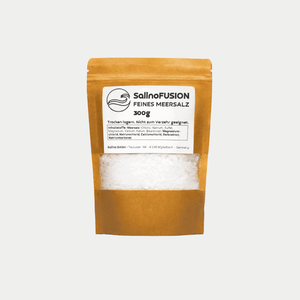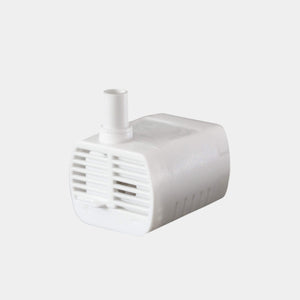Sophia sits on a light wooden chair, her hands wrapped around a cup of overly hot tea, and watches her four-year-old daughter Mila play. The girl builds a tower. Again and again. And in between, she breathes – deeply, without that whistling sound that's usually always there. For weeks, Sophia has been searching for a place like this. A salt playroom where children are not only welcome, but where the air is also different. Clearer. Saltier. More healing.
Salt play rooms, salt inhalers, or salt playgrounds—as they are called depending on the provider—are not a new invention, but they are becoming increasingly popular. They are silent alliances between relaxation and therapy, between everyday life and mindfulness. Places where families can relax while their children play and, at the same time, inhale something that opens airways, relieves inflammation, and strengthens the immune system. In a time when infections follow one another seamlessly, when every cold becomes a strain, parents are looking for spaces that offer more than distraction. They are looking for air to breathe—literally.
This article is an invitation to take a closer look: What's behind these special places? How does salt air affect small airways? And what if the nearest salt-playing area is too far away—are there ways to bring that feeling of lightness home?
The room that breathes: What makes salt playrooms and salt inhalers special
The idea is as simple as it is plausible: Take a room, fill the floor with fine salt—sometimes several tons of it—and then spray the finest salt particles with special generators. Provide child-friendly toys, and thus create a place where children enjoy being. Not have to. Want to be.
Salt playrooms and salt inhalers combine the pleasant with the beneficial. While children romp, build, dig, and climb in the salt playroom, they also inhale the finest salt particles released into the air by halogen generators. These particles are so small that they can penetrate deep into the respiratory tract, where they exert anti-inflammatory, expectorant, and antibacterial effects.
The terms vary depending on the provider: "salt playroom," "salt playground," "salt inhalation center," "salt playroom," or even "children's salt paradise." They all share the same concept: children play in a room with salty air—like at the beach, except the floor is covered with salt instead of sand. Some providers combine the salt playroom with a café area for parents, while others focus purely on the therapeutic play environment.
An atmosphere that carries
What distinguishes these spaces from ordinary indoor playgrounds is not just the air, but the overall atmosphere. Many of these places are deliberately designed to be tranquil. Dim lighting, light wood tones, and salt stones on the walls create a warm, almost meditative atmosphere. These aren't noisy, romping halls, but rather places of well-being – for children who need to relax and for parents who want to breathe easy.
Facilities such as "Salznest" in Essen, "slöks" with its accompanying educational concept, "Kids Safari" in Leipzig, or the "Babybeach" locations nationwide demonstrate how diverse the implementation can be. While some providers, such as "Pamila" in Worms or "die Salzkiste" in Solingen, combine a children's café with a salt room, others, such as "Salzkasten" or "Happy Kids Salzspielplatz," rely solely on salt inhalers with a play area.
Between play and therapy: A new approach

For many children, a traditional inhalation session involves sitting still. Putting on a mask. Waiting. Sometimes tears. Salt play rooms reverse this concept. There's no "You have to inhale now." Instead, children play for 45 minutes in an environment reminiscent of a beach—with molds, shovels, slides, and climbing frames. And the inhalation happens incidentally, without the child perceiving it as therapy.
For children with chronic respiratory diseases such as asthma, bronchitis, or recurring infections, this playful form of halotherapy can bring noticeable relief. Healthy children also benefit: Their airways are humidified, cleansed of dry, heated air or urban pollution. The immune system is strengthened. And sometimes it's simply the feeling of being able to breathe deeply that makes a difference.
How salt air affects small lungs: Science meets intuition

Salt air isn't esoteric, but biophysics. For centuries, people have been harnessing the healing effects of salty air – on the coast, in salt mines, and in artificially created grottos. Modern medicine calls this form of therapy "halotherapy," derived from the Greek word for salt: "halos."
The mode of action: small, fine, deep
In salt rooms and saline inhalers, a 14 percent saline solution is typically nebulized by special generators. When salt is atomized into the finest particles—we're talking about sizes between 1 and 5 micrometers—it can penetrate deep into the respiratory tract. There, it exerts several effects:
It binds moisture and helps loosen stubborn mucus. It has an antibacterial effect and reduces bacterial load in the respiratory tract. It inhibits inflammatory processes by soothing the mucous membranes. And it can dilate the airways, which is especially relevant for children with obstructive airway diseases.
These mechanisms are scientifically documented. Studies in the fields of pulmonology and pediatric allergology show that regular salt air therapy can reduce the frequency of respiratory infections and improve lung function. Rapid effects are often seen, especially in children, whose airways are even more sensitive and reactive than those of adults.
Not a miracle cure, but a building block
It's important to note that salt air is not a substitute for medical treatment. It's not a medication, nor an acute intervention for an asthma attack, nor a solution for serious lung diseases. But it is a useful, natural component in a holistic approach—especially for prevention and for mild to moderate chronic conditions.
Pediatricians and pulmonologists often recommend halotherapy as a supplement – for example, for chronic bronchitis, sinusitis, hay fever , or for the aftercare of respiratory infections. The German Lung Foundation points out that salt supports the self-cleaning function of the respiratory tract without causing side effects. This makes it one of the few forms of therapy that can be safely used in babies from the eighth week of life.
Why children benefit
Children's lungs are not simply small adult lungs. They are still growing, their airways are narrower, and their mucous membranes are more sensitive. At the same time, children are more likely to get sick: Up to twelve infections per year are considered normal in early childhood. Every infection leaves its mark—irritated mucous membranes, inflamed bronchi, and weakened immune systems.
Salt air in salt play rooms offers a gentle, non-invasive way to support regeneration. It helps clear the respiratory tract, reduce inflammation, and strengthen the immune system. And best of all, children usually don't even realize they're "doing something for their health." They simply play while the salt air does its work.
Where there are salt margins – and why they are often far away
Searching for a nearby salt room can be sobering. While some regions have several providers, entire regions remain without such offerings. The concentration is primarily in urban areas and larger cities.
The landscape of salt inhalers in Germany
If you search for "salt playroom", "salt inhalation room" or "salt playground", you will find providers such as:
- Babybeach locations : A franchise concept with locations in Leipzig, Freiburg, Rotenburg, Essen and other cities
- Salt Nest in Essen: Salt playroom with saline inhalation
- Kids Safari in Leipzig: Salt inhalation room with indoor playground
- Pamila Children's Café in Worms: Combination of café and salt room
- The Salzkiste in Solingen: Family café with salt inhalation room
- And many more!
The terminology varies, but the principle remains the same: children play in a room with salty air, while parents can often wait in a separate area – sometimes with a café, sometimes without.
The problem of accessibility
Many families face the problem: The nearest salt therapy room is an hour's drive away, or even further. Regular visits—often recommended are one or two sessions per week for acute complaints, or one visit per month for preventative care—become a logistical challenge. Time, travel costs, and coordination with other appointments—for many families, this is unfeasible.
In addition, not every family can afford the sessions. Prices vary, but typically range between €10 and €20 per child per session. With regular use, this quickly adds up to a significant amount.
When the journey is too far: Salt air in your own home

It sounds ideal: a nearby salt playroom where you can regularly visit while your children play in the salty air. But the reality is often different. Salt playrooms and salt inhalers are rare. In many regions, they don't even exist. In others, they are far away, expensive, or difficult to integrate into the schedule.
So what do you do when the nearest salt playground is an hour's drive away? When your budget is tight? When your week is already packed with daycare, work, doctor's appointments, and trying to juggle everything?
The solution that fits in the living room
This is where compact salt air devices come into play – small, often inconspicuous devices designed for home use . They create a microclimate of fine salt particles, similar to the large halogen generators in professional salt rooms, only in miniature.
A device such as the "Mini Saline" can be used in the children's room, the living room, or even next to the bed at night. It operates quietly and unobtrusively, without requiring active inhalation. The salt air disperses throughout the room, and everyone in it breathes it in naturally.
Not a replacement, but an alternative
Of course, a small device can't replicate the atmosphere of a salt playroom. It lacks the experience of playing in salt, the community with other children, the special environment, the conscious escape from everyday life. But it offers something else: availability. Regularity. The opportunity to integrate salt air into everyday life, without effort, without an additional appointment.
For families who don't have the opportunity to regularly visit a saline playroom or saline inhalation room, such a device can be a useful addition. Especially during cold season, when the respiratory tract is already irritated. Or for children who struggle with a stuffy nose at night and therefore have trouble sleeping.
What to look out for
Not every device is the same. Some work with vaporization, others with ultrasound, and still others with mechanical atomization. The decisive factor is the correct particle size – only particles under 5 micrometers reach the lower respiratory tract. Devices that merely emit a "salt scent" have no therapeutic effect.
Reputable providers specify the particle size, explain how it works, and avoid exaggerated claims of healing. A good salt air device for the home should be quiet, easy to use, low-maintenance, and ideally work with natural salt – no additives, no chemicals.
Between longing and structure: What families really need
Salt playrooms and salt inhalers are more than a health-promoting approach. They express a greater longing: for spaces that don't overwhelm families, but rather support them. For spaces where children can be healthy without health becoming a routine. For moments where parents don't have to function, but can simply be there.
The dilemma of modern parenthood
We live in a time where parenthood is often equated with optimization. Early childhood education, healthy nutrition, sufficient exercise, emotional support, language development—the list is long, and it's growing longer every day. Added to that is the pressure not to take a back seat professionally, not to neglect one's relationship, not to lose oneself.
In this field of tension, places like salt playrooms are small islands. They don't promise to solve everything. But they offer something precious: a space where several needs can be met simultaneously. Children can play. Parents can breathe easy. And, incidentally, something good for health happens.
Health as a by-product
That's perhaps the smartest aspect of these places: They make health a byproduct, not a necessity. No one has to persuade their child to "take a deep breath." No one has to fight for 20 minutes of inhalation. The salt air is simply there, while life goes on.
This low-threshold approach is especially valuable for families with chronically ill children. Therapy is often stressful – for everyone involved. It involves doctor's appointments, waiting times, medication schedules, and sometimes even tears and resistance. However, when therapy takes place in a pleasant environment where children enjoy being, it loses its threatening nature. It becomes part of life, not an interruption.
The future breathes a sigh of relief: A look ahead
Salt play rooms and saline inhalers could become more common in the coming years. The demand is there. Awareness of holistic, preventative health approaches is growing. And the experience of many parents shows: It works. Children who regularly inhale salt air are less likely to get sick, recover faster, and breathe more freely.
At the same time, it will be important that these places remain accessible—not just for urban middle-class families, but for everyone. Salt air therapy should not be a luxury, but a natural addition to the healthcare system. Some health insurance companies are already beginning to support halotherapy. This is a start.
If the path remains too long
For families without access to a salt playroom or salt inhalation room, there remains the option of bringing salt air into the home. Devices like the "Mini Saline" offer a practical alternative—not as a replacement for the play experience and atmosphere of a salt playroom, but as a way to still reap the health benefits. They are compact, quiet, and can be easily integrated into everyday life—for example, in the children's room during sleep or in the living room during play.
The important thing to remember is that it's not about turning your home into a therapy room. It's about giving your children something that's good for them—without effort, without drama, without it feeling like "just another thing on the list."
A space to breathe
Ultimately, all of this comes down to one thing: space. Space to breathe—physically and metaphorically. Space for children to get and stay healthy. Space for parents to breathe deeply without guilt. Space for families to simply be.
Salt playrooms and salt inhalers create this space. And if they're too far away, there are ways to bring a piece of it into your own home. Not perfect, not always easy—but possible. And sometimes that's enough.
Note: For families without regular access to salt air treatment rooms or saline inhalers, a compact salt air device for the home can be a practical addition. The "Mini-Saline" is such a device, designed to distribute fine salt aerosol throughout living spaces – quietly, unobtrusively, and without any active intervention. It is not a substitute for professional halotherapy in salt air treatment rooms, but can provide helpful support in everyday life, especially during cold season or for chronic respiratory problems.



